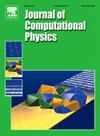热化学非平衡气体混合物的Petrov-Galerkin模型还原
IF 3.8
2区 物理与天体物理
Q2 COMPUTER SCIENCE, INTERDISCIPLINARY APPLICATIONS
引用次数: 0
摘要
特定状态的热化学碰撞模型对于准确描述涉及非平衡等离子体的系统的物理特性至关重要,但它们在计算上也很昂贵,而且对于大规模、多维模拟来说不切实际。从历史上看,通过使用经验和基于物理的参数来降低控制方程的复杂性,可以降低计算成本。然而,由此产生的模型往往是不准确的,它们不能捕捉到原始物理的重要特征。此外,这些模型的构造通常是不切实际的,因为它需要大量的用户监督和耗时的参数调优。在本文中,我们通过一个基于非线性动力学方程在低维子空间上的Petrov-Galerkin投影的易于实现且计算效率高的模型简化管道来解决这些问题。我们的方法是合理的,因为观察到热非平衡中的动力学系统倾向于表现出低阶动力学,这种低阶动力学迅速地将状态推向可以用于降阶建模的低维子空间。此外,尽管控制方程具有非线性性质,但我们观察到这些系统的动力学在子空间上演化,这些子空间可以使用关于热化学平衡稳态的线性化方程精确识别,我们将看到这使我们能够显着降低与模型构建相关的成本。该方法在两种不同的热化学系统中得到了证明:一种是O2-O系统的振动碰撞模型,另一种是O2-O和O2-O2组合系统的振动碰撞模型。我们的方法实现了高精度,宏观量(即矩)的相对误差小于1%,微观量(即能级人口)的相对误差小于10%,同时还提供了出色的压缩率和加速,优于现有的最先进的技术。本文章由计算机程序翻译,如有差异,请以英文原文为准。
Petrov-Galerkin model reduction for thermochemical nonequilibrium gas mixtures
State-specific thermochemical collisional models are crucial to accurately describe the physics of systems involving nonequilibrium plasmas, but they are also computationally expensive and impractical for large-scale, multi-dimensional simulations. Historically, computational cost has been mitigated by using empirical and physics-based arguments to reduce the complexity of the governing equations. However, the resulting models are often inaccurate and they fail to capture the important features of the original physics. Additionally, the construction of these models is often impractical, as it requires extensive user supervision and time-consuming parameter tuning. In this paper, we address these issues through an easily implementable and computationally efficient model reduction pipeline based on the Petrov-Galerkin projection of the nonlinear kinetic equations onto a low-dimensional subspace. Our approach is justified by the observation that kinetic systems in thermal nonequilibrium tend to exhibit low-rank dynamics that rapidly drive the state towards a low-dimensional subspace that can be exploited for reduced-order modeling. Furthermore, despite the nonlinear nature of the governing equations, we observe that the dynamics of these systems evolve on subspaces that can be accurately identified using the linearized equations about thermochemical equilibrium steady states, and we shall see that this allows us to significantly reduce the cost associated with the construction of the model. The approach is demonstrated on two distinct thermochemical systems: a rovibrational collisional model for the O2-O system, and a vibrational collisional model for the combined O2-O and O2-O2 systems. Our method achieves high accuracy, with relative errors of less than 1% for macroscopic quantities (i.e., moments) and 10% for microscopic quantities (i.e., energy levels population), while also delivering excellent compression rates and speedups, outperforming existing state-of-the-art techniques.
求助全文
通过发布文献求助,成功后即可免费获取论文全文。
去求助
来源期刊

Journal of Computational Physics
物理-计算机:跨学科应用
CiteScore
7.60
自引率
14.60%
发文量
763
审稿时长
5.8 months
期刊介绍:
Journal of Computational Physics thoroughly treats the computational aspects of physical problems, presenting techniques for the numerical solution of mathematical equations arising in all areas of physics. The journal seeks to emphasize methods that cross disciplinary boundaries.
The Journal of Computational Physics also publishes short notes of 4 pages or less (including figures, tables, and references but excluding title pages). Letters to the Editor commenting on articles already published in this Journal will also be considered. Neither notes nor letters should have an abstract.
 求助内容:
求助内容: 应助结果提醒方式:
应助结果提醒方式:


